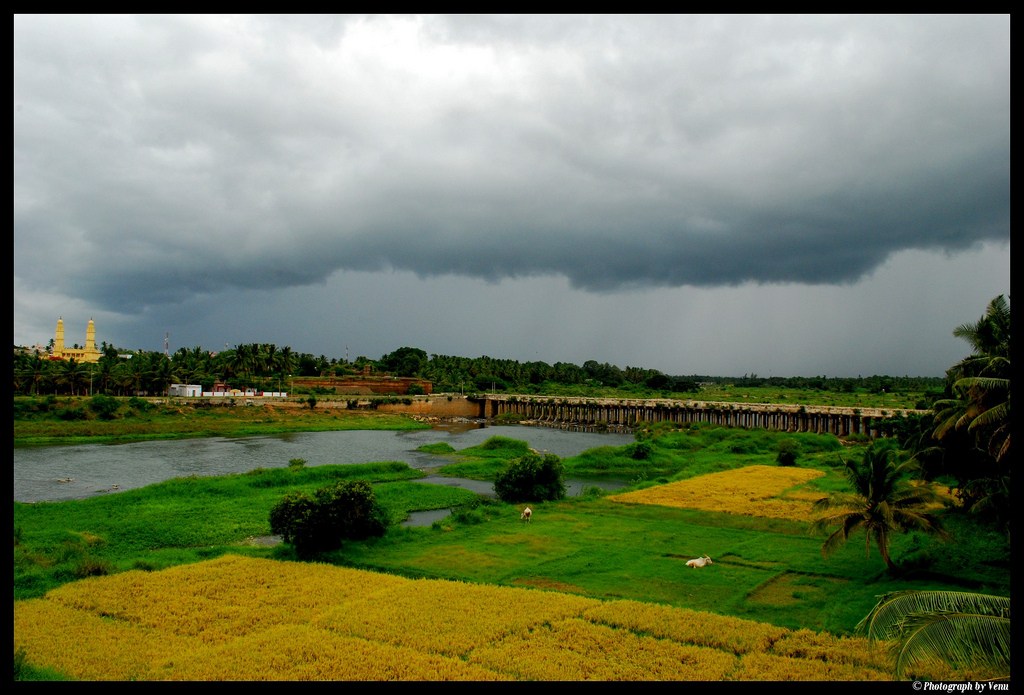Protests Break Out After India’s Supreme Court Rules in Favor of Downstream State in Cauvery River Dispute
A decades-long quarrel over water allocations boils up again during this year’s dry summer, ending in farmer protests and increased security.

Today, thousands of farmers in southern India tried to take control of two dams and halt mandated water releases that are at the center of a water dispute between neighboring states, The Hindu reports.
The protesters broke through a police cordon at the Krishna Raja Sagar and Kabini dams in the state of Karnataka, resulting in injuries to both protesters and police.
The attempted siege follows a weekend when farmers took to the streets to protest the Supreme Court’s decision on Friday that, despite one of the worst droughts in decades, Karnataka would have to meet water-delivery requirements to its downstream neighbor, Tamil Nadu.
The ruling affirmed a previous decision made on September 19 by the Cauvery River Authority (CRA), a management body comprised of Indian Prime Minister Manmohan Singh and top state government officials in one of the country’s most contentious river basins. The CRA rarely convenes, usually only in dry periods.
Meeting in mid-September for the first time since February 2003, the CRA ordered Karnataka to release water at a defined rate of 255 cubic meters (9,000 cubic feet) per second every day to its downstream neighbor until October 15, the beginning of the winter monsoon and the start of the rainy season in Tamil Nadu.
The Supreme Court’s ruling legitimizes the work of the CRA, said Ashok Swain, a professor at Uppsala University Sweden and an expert on international water conflicts.
Still, the decision rankled farmers, who, in addition to the agitation at the dams, have blocked major intersections along an important highway in the last few days, the Deccan Chronicle reports.
Long Disagreement
There is no spare water in the Cauvery Basin — it is fully used and fully allocated. Farmers in both Karnataka and Tamil Nadu apply more than 90 percent of the basin’s water to their rice paddies and fields, while the demand in urban hubs like Bangalore, the capital of Karnataka, grows steadily. The river reaches the sea only during a strong monsoon season, which is not the case this year.
Best known for its tech industry and as the place where U.S. customer service calls are transferred, Bangalore is one of the fastest-growing urban areas in India. Now home to 9.5 million, it grew by nearly 50 percent in the decade that ended in 2011.
Since the 1970s, Bangalore has drawn water from the Cauvery. Just two weeks ago, the city tested its latest pipeline from the contested river. The Times of India reports that the line will pump at full capacity by November, increasing the city’s Cauvery supply by more than 60 percent.
Violence, protests, and even death over water is an unfortunate precedent in the Basin. In 1991, after an interim ruling from a newly formed water tribunal came down in favor of Tamil Nadu, riots in Bangalore killed 23 people, mostly Tamils, a minority group there. Then in 2002, a farmer in Karnataka jumped into a reservoir, killing himself, to protest water deliveries to Tamil Nadu.
Political Wedge
Nonetheless, it is politics that drives a wedge between the quarreling states, argues Swain, who told Circle of Blue that the main political parties in each state use the conflict to bolster their standing.
“This water issue,” Swain wrote in an email, “provides a very powerful and emotive tool to the political actors in Karnataka and Tamil Nadu for political mobilization. Both the states have preferred to address the water sharing as a zero-sum game, rather than working towards finding a suitable and long-term solution.”
That solution, he says, will not come until India’s Supreme Court stamps its approval on the work of the basin’s water tribunal, which developed a water allocation plan in 2007 that remains in legal limbo today.
Meanwhile, in a last-ditch attempt, the Karnataka government has petitioned the CRA to rescind the recent water-delivery order.
Source: Asien: Water Stress in the Cauvery Basin, Deccan Chronicle, The Hindu, Times of India
Brett writes about agriculture, energy, infrastructure, and the politics and economics of water in the United States. He also writes the Federal Water Tap, Circle of Blue’s weekly digest of U.S. government water news. He is the winner of two Society of Environmental Journalists reporting awards, one of the top honors in American environmental journalism: first place for explanatory reporting for a series on septic system pollution in the United States(2016) and third place for beat reporting in a small market (2014). He received the Sierra Club’s Distinguished Service Award in 2018. Brett lives in Seattle, where he hikes the mountains and bakes pies. Contact Brett Walton






Leave a Reply
Want to join the discussion?Feel free to contribute!